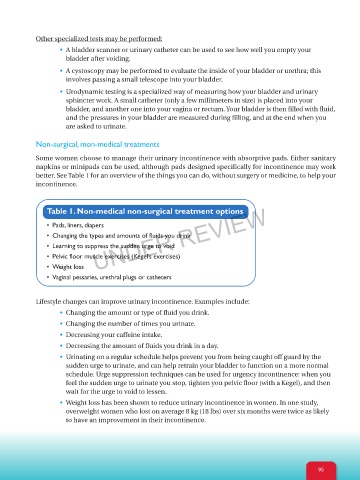Page 94 - Urological Health
P. 94
Other specialized tests may be performed:
• A bladder scanner or urinary catheter can be used to see how well you empty your
bladder after voiding.
• A cystoscopy may be performed to evaluate the inside of your bladder or urethra; this
involves passing a small telescope into your bladder.
• Urodynamic testing is a specialized way of measuring how your bladder and urinary
sphincter work. A small catheter (only a few millimeters in size) is placed into your
bladder, and another one into your vagina or rectum. Your bladder is then filled with fluid,
and the pressures in your bladder are measured during filling, and at the end when you
are asked to urinate.
Non-surgical, mon-medical treatments
Some women choose to manage their urinary incontinence with absorptive pads. Either sanitary
napkins or minipads can be used, although pads designed specifically for incontinence may work
better. See Table 1 for an overview of the things you can do, without surgery or medicine, to help your
incontinence.
UNDER REVIEW
Table 1. Non-medical non-surgical treatment options
• Pads, liners, diapers
• Changing the types and amounts of fluids you drink
• Learning to suppress the sudden urge to void
• Pelvic floor muscle exercises (Kegel’s exercises)
• Weight loss
• Vaginal pessaries, urethral plugs or catheters
Lifestyle changes can improve urinary incontinence. Examples include:
• Changing the amount or type of fluid you drink.
• Changing the number of times you urinate.
• Decreasing your caffeine intake.
• Decreasing the amount of fluids you drink in a day.
• Urinating on a regular schedule helps prevent you from being caught off guard by the
sudden urge to urinate, and can help retrain your bladder to function on a more normal
schedule. Urge suppression techniques can be used for urgency incontinence: when you
feel the sudden urge to urinate you stop, tighten you pelvic floor (with a Kegel), and then
wait for the urge to void to lessen.
• Weight loss has been shown to reduce urinary incontinence in women. In one study,
overweight women who lost on average 8 kg (18 lbs) over six months were twice as likely
to have an improvement in their incontinence.
95

